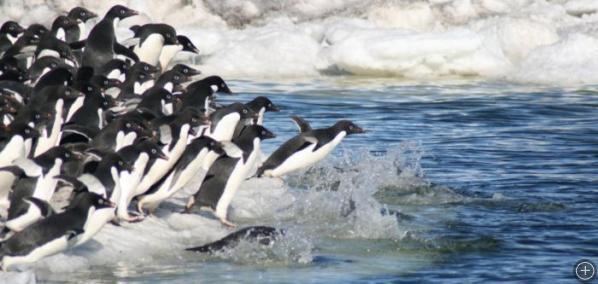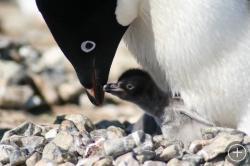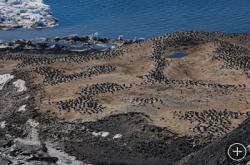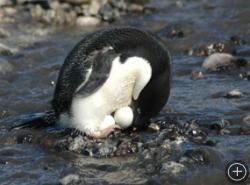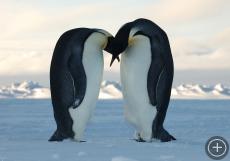Penguins
Although the penguin is the icon of the Antarctic, many penguins prefer lower latitudes. Several species venture as far south as the Antarctic Peninsula, but only the emperors and the Adélies live along the continental coastline.
Adélies
If you were to conjure up an image of a penguin, it would probably look quite a lot like an Adélie: With a black back and white front, it’s the archetypical tuxedo-clad penguin. Named for Adéle, the wife of French explorer Admiral Durmont d’Urville, the Adélie is also one of the best-studied penguins.
Adélies spend most of the year at sea, but in October, when spring comes to Antarctica, they head for dry land on which to build nests, mate, lay eggs, and raise their chicks. An Adélie nest is lined with small stones. Prize pebbles are squabbled over and often purloined from inattentive neighbors.
In early November, the female lays two eggs and returns to the sea to feed, leaving the male to be the eggs’ first caretaker. The parents take turns incubating the eggs though, which hatch in about 35 days, and they continue to alternate between gathering food and watching over the young chicks.
Finally, the growing chicks, too hungry to be provisioned by just one parent at a time, are left together in a tightly packed group called a crèche, while both parents go hunting. In February, the juveniles exchange their down coats for seaworthy adult feathers and, along with the adults, soon leave the breeding ground for the pack ice.
Adélies breed in a number of places along the Antarctic coast, from the Ross Sea in the south to the Antarctic Peninsula far to the north. The southernmost quartet of colonies—at Cape Crozier, Cape Bird, and Cape Royds on Ross Island and another on Beaufort Island—differ from each other in size, weather, and distance from the open sea. Cape Crozier, known as Penguin City, is by far the largest, with about 150,000 breeding pairs. The trip from Penguin City to the ocean is a short one, but the large number of birds means that competition for food is intense. Life is more of a picnic for the penguins in the smaller colonies, even if they must walk a bit farther to reach the food.
In general, though, all the Ross Sea Adélies are doing well. Climate change has brought stronger winds that keep the water near the shore almost free of ice, making feeding areas more accessible. A warmer climate is benefiting these penguins—for the moment. But if temperatures continue to climb, these birds will face the severe problems being experienced by the Adélie in the Antarctic Peninsula region.
In the many months that the Adélies are away from land, they’re dependent on sea ice. It’s where they hunt and otherwise live. If their winter habitat is diminished, so are the penguins. This is currently the plight of the Adélies near the western Antarctic Peninsula—the region of Antarctica that’s experienced the greatest warming and greatest loss of sea ice. In addition, commercial fisheries and growing numbers of whales are increasingly competing for the reduced numbers of krill, a staple of the Adélie diet. This penguin population has declined by 80 percent since the 1970s.
Other climate changes will probably affect the breeding success of the Adélies. Antarctica is the driest place on earth—but with higher temperatures comes more precipitation and more meltwater from current snowfall and ancient glaciers. The pebbles that line an Adélie nest will protect the eggs from a small amount of meltwater, but a significant amount of meltwater will wash them away. And a serious snowstorm can not only destroy the eggs but can bury a stoic parent who tries to shelter them.
According to biologist David Ainley, who’s been studying Adélie penguins in Antarctica for more than twenty-five years, “If global warming begins to influence the more southern reaches of the Antarctic continent, then the entire world’s population of Adélie penguins could be at risk.”
Emperors
The story of the emperors is one of superlatives: They are the tallest penguins, and the heaviest. They can dive the deepest. And they breed and raise their chicks in the harshest environmental conditions.
Unlike any other penguin, emperors raise their young during the Antarctic winter. Undaunted by fierce winds and plummeting temperatures, the mature emperors heave themselves out of the sea in March and head for their breeding grounds. The trek may be a long one: In the film March of the Penguins, the emperors walk about 70 miles (113 km), but for some other colonies, the distance is considerably less. Most colonies—there maybe 25 to 30—breed on fast ice along the coast, although two known colonies breed on land.
Courtships happen in a hurry, and in May or early June each female lays a single egg that must be carefully transferred to the feet of her mate. The male covers the egg with a flap of skin from its abdomen called a brood pouch and incubates the egg for two months. To keep warm during this dark, cold time, the papa penguins huddle closely together, taking turns being on the outside and inside of the group.
Once the eggs are safely in the care of the males, the females immediately return to the sea to hunt. If all goes well, they’ll be back in time to feed their newly hatched chicks. Then, like Adélie parents, the adults alternate making trips to the sea to satisfy the voracious appetites of their fast-growing youngsters. Eventually, when the chicks are large enough to take care of themselves, the parents begin to forage at the same time. In December or January, all the birds make their way to the sea—a shorter distance now that, with warmer temperatures, some of the fast ice has broken out.

Emperors march single-file from the sea to their breeding grounds in a line that may contain thousands of individuals.
The emperors have amazing adaptations that help them withstand the cold, go without food for many long weeks, and make arduous trips back and forth to the sea. Their adaptations for diving are impressive as well. Their dives have been measured to 1800 feet (550 m) and dives lasting more than 20 minutes have been recorded. Pressure increases with depth, which endangers gas-filled organs such as the lungs, but the emperors can protect their lungs by collapsing them. This stops the transfer of oxygen from the lungs to the bloodstream, but the emperors conserve oxygen by slowing their heart rate during dives. They also have extraordinary amounts of oxygen stored in muscle tissue and can use virtually all the oxygen in their bloodstream before having to surface for more.
Paul Ponganis, who is both a research biologist and an anesthesiologist, studies diving penguins at Antarctica’s Penguin Ranch research facility with his colleague from the Scripps Institution of Oceanography, Jerry Kooyman. Ponganis thinks that what they learn about emperor physiology may have applications for human medical care such as for stroke victims who can sustain permanent damage if their brains don’t get enough oxygen.
Emperors have successfully survived for millennia, but as the environment undergoes rapid changes, their future is uncertain. Global warming may result in thin, unstable fast ice that breaks out too early, drowning eggs or chicks. Emperors also seem likely to face a declining food supply due both to pressure from commercial fisheries and to climate change.
In December 2008, however, the U.S. Fish and Wildlife Service denied protection under the Endangered Species Act (ESA) to the emperor penguin and two other penguins it had considered, although it did propose to list six penguin species. According to its news release on December 17, “The Service does not have sufficient scientific information to conclude that in the foreseeable future, the habitat of the emperor penguin will be altered to the point where the species is threatened with extinction.”

